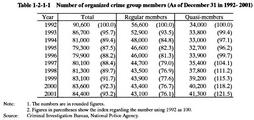| Previous Next Index Image Index Year Selection | |
|
|
1 Trends in organized crime groups Table 1-2-1-1 shows the trends in the number of both regular members and quasi-members of organized crime groups (hereinafter referred to as "organized crime group members") from 1992 to the end of 2001.
Fig. 1-2-1-2 shows the trends in the number of incidents of rivalries between organized crime groups that occurred over the last decade and the rate of firearm use (the rate of firearm use to the number of incidents of rivalries between organized crime groups). In 2001, the number of incidents of rivalries between organized crime groups was 81, increasing by 63 from the previous year, and the rate of firearm use was 87.7%. Table 1-2-1-1 Number of organized crime group members (As of December 31 in 1992-2001) As of December 31, 2001, 24 organized crime groups including 3 major groups (the Fifth Yamaguchi-Gumi, the Inagawa-Kai and the Sumiyoshi-Kai) were designated as designated organized crime groups under the Law to Prevent Unjust Acts by Organized Crime Group Members (hereinafter referred to as "Anti-Organized Crime Group Law" in this section). The number of regular members who belonged to the 3 major groups was around 30,400 (up by around 400 persons from the previous year), accounting for 70.5% of the total number of regular organized crime group members.Under the Anti-Organized Crime Group Law, 2,238 stop orders , whose aim is to discontinue unjust acts, and 96 recurrence preventive orders , whose aim is to prevent recurrence of such acts, were issued in 2001 respectively increasing by 53 and by 1 from the previous year (Source: Criminal Investigation Bureau, National Police Agency). Fig. 1-2-1-2 Trends in the number of incidents of rivalries between organized crime groups (1992-2001) |

